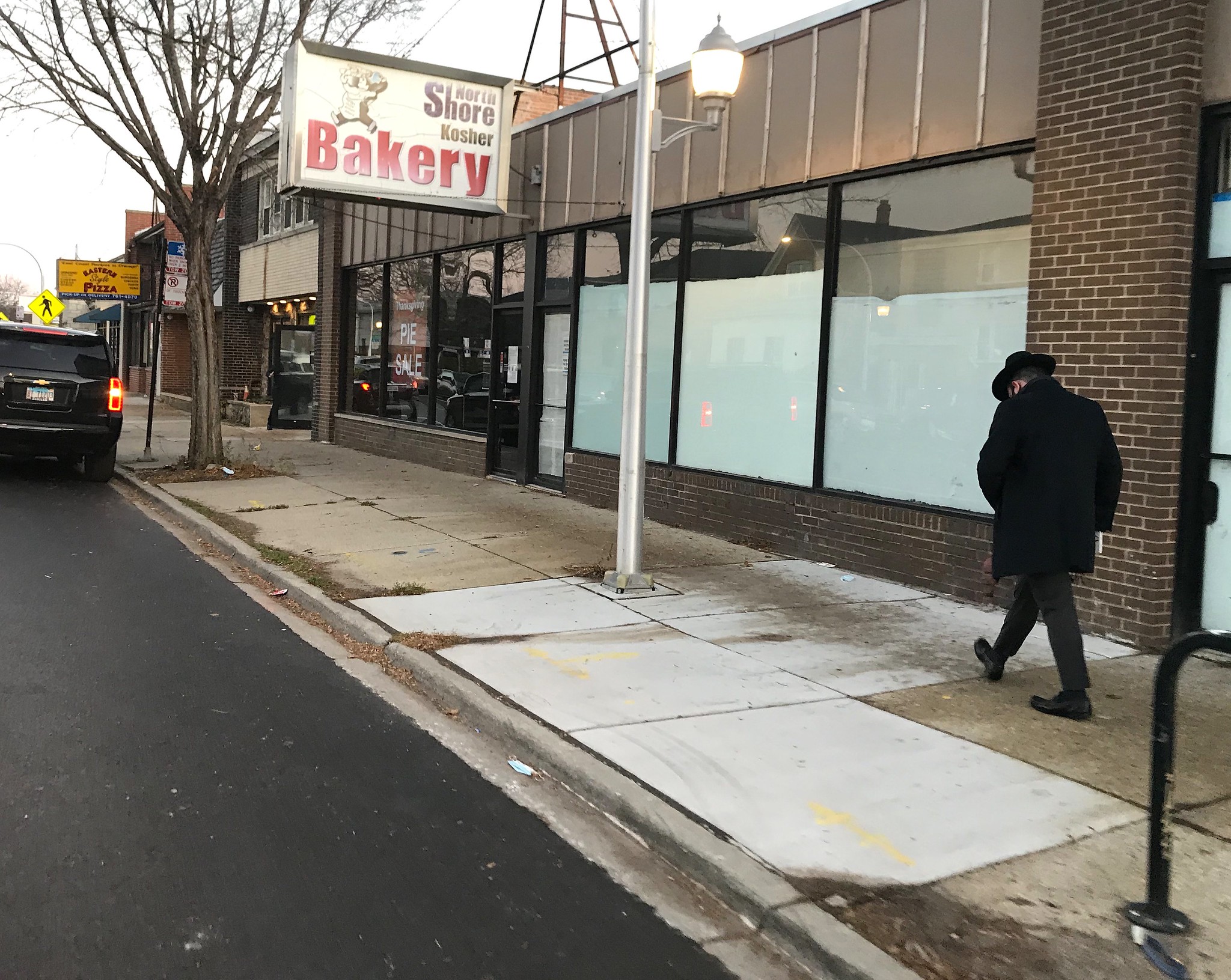[A version of this piece ran in the Chicago Reader.]
West Rogers Park, officially designated by the city of Chicago as the West Ridge community area, is home to the midwest's largest Haredi, or strict Orthodox, Jewish community (some members view the term "ultra-Orthodox" as disparaging.) It's known for the dark suits, fedoras, and beards, or headscarves and long dresses, worn by many adherents. By some estimates, Jews of various stripes make up about one in three of the 77,000-plus residents of West Ridge. The area also includes vibrant Indian, Pakistani, Bangladeshi, and Assyrian communities.
Nowadays West Rogers Park's strict Orthodox community is primarily located between Peterson Avenue and Howard Street, and concentrated west of California Avenue. That boundary gave its name to neighborhood native Adam Langer's 2004 memoir "Crossing California."
Among the many ways this enclave is unique in Chicago is politics. An estimated 77 percent of all U.S. Jews voted for Joe Biden in November. But the heavily-Haredi precincts of West Ridge and the neighboring North Park community area were just about the only parts of Chicago that went for Donald Trump in both 2016 and 2020 that aren't home to large numbers of police officers. Trump is popular with many strict Orthodox Jews in part due to his hard-line positions on Israeli-Palestinian issues, and his support for "school choice," using taxpayer money to subsidize tuition at private schools, including religious institutions like West Rogers Park's many yeshivas, Orthodox Jewish schools.
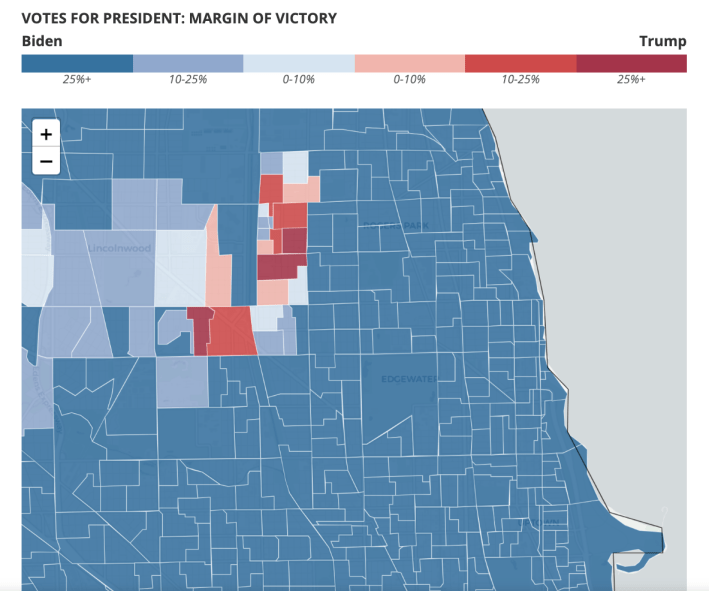
The local Haredi community is sometimes viewed as being closed off to outsiders, but it recently got a new entryway. On November 10, city officials finally cut the ribbon on the $3.4 million Lincoln Village Pedestrian Bridge, which links two segments of the bike trail that parallels the North Shore Channel, the western boundary of West Ridge, just north of Lincoln Avenue.
15 years earlier, feisty 50th Ward alderman Berny Stone blocked the construction of the already-designed and funded span under mysterious circumstances, much to the chagrin of local bicyclists. The longtime Council member was defeated by Debra Silverstein in 2011 and passed away in 2014, and Silverstein relaunched the project. In light of the span's checkered history, I've dubbed it the Stone Free Bridge, after the eponymous Jimi Hendrix song.
After the ceremony, Chicago Department of Transportation staff members pointed out a squarish archway on the east side of the bow truss bridge that I hadn't noticed before. They explained that the structure was incorporated into the design at the behest of Orthodox Jews as a portal to the West Rogers Park Eruv.
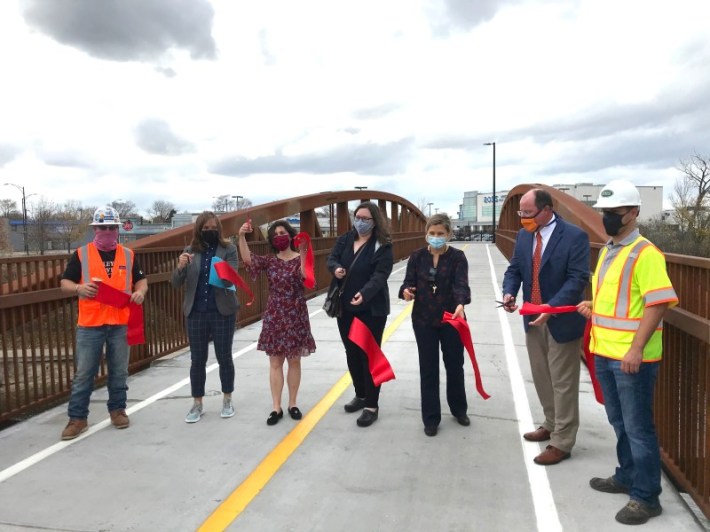
An eruv (pronounced "AY-roove") is a symbolic enclosure around a Jewish community within which certain activities are permitted that would normally be banned during the Sabbath, Friday sunset to Saturday sundown (called Shabbat in Hebrew and Shabbos in Yiddish, the language of eastern and central European Jews) as well as on Yom Kippur. An eruv is typically bounded by existing walls, utility poles, and wires, with additional infrastructure added if necessary to complete the circuit according to halakha, Jewish religious law. There's also an eruv that straddles Lakeview and Lincoln Park by the lake, where there are several synagogues, plus others in the northern suburbs of Lincolnwood, Skokie, Buffalo Grove, Northbrook, and Highland Park.
The CDOT staffers were fuzzy on exactly who requested the arch, as well as the function of the eruv, so I reached out to Silverstein for more info. The alderman is Orthodox herself, although not strictly so—she avoids driving on Shabbat, which is prohibited, but wears typical street clothes.
Asked what it's like being the rep for Chicago's Haredi neighborhood, Silverstein said, "I'm really proud that I'm alderman of one of the most diverse wards in Chicago... It's really great that we all get along and get together and learn from one another."
Silverstein said a member of the West Rogers Park Eruv committee met with CDOT to discuss how to incorporate the bridge into the ritual enclosure.
Transportation department spokesperson Mike Claffey confirmed that, adding that the cost of the arch "was minimal in terms of the project budget."
Neither Silverstein nor CDOT would tell me straight out who the committee representative was. But Silverstein referred me to the Chicago Rabbinical Council for more info on the eruv and other transportation-related matters in the Haredi community.
Rabbi Yona Reiss, chief rabbinical judge at CRC, explained that strict Orthodox Jews, or as he called them "Torah-observant Jews," aren't easily taxonomized into specific classes. Rather, there's a continuum of "different flavors and degrees of dress and practice."
For example, Rabbi Reiss said while all Orthodox Jewish people should strive to dress in a way that "respects modesty and dignity," there are varying opinions on what that means. Observant males cover their heads with a yarmulke out of deference to God, and some wear a tallit katan, a version of a prayer shawl, under their garments so that the fringe is visible, "as a reminder to observe all the mitzvot," or biblical commandments. An edict from the book of Leviticus has been translated as "You shall not shave the corners of your head," which some Haredim interpret as mandating sidelocks and/or beards for those who can grow them.
Strict Orthodox females typically wear long dresses, keep their shoulders and arms covered, and avoid necklines that drop below the collarbone. Married women are supposed to conceal their hair, although some accomplish this by wearing wigs, Reiss said.
During the bridge ribbon-cutting, which took place on a Tuesday, I was surprised to see what appeared to be a Haredi woman jogging on the North Shore Channel Trail in a longish dress, leggings, and a headscarf. But Reiss said, other than during Shabbos, there aren't any particular restrictions on physical activity and transportation. "As long as you can maintain modesty, exercise is a good thing."
Of course, on the day of rest it's another story. Recreation or play is generally frowned upon, with some allowances made for young children. Biking is not permitted, except for toddlers' tricycles, and there's no traveling in cars or on transit except for medical emergencies. Therefore, Orthodox Jews tend to plan their lifestyles around walking to synagogue.
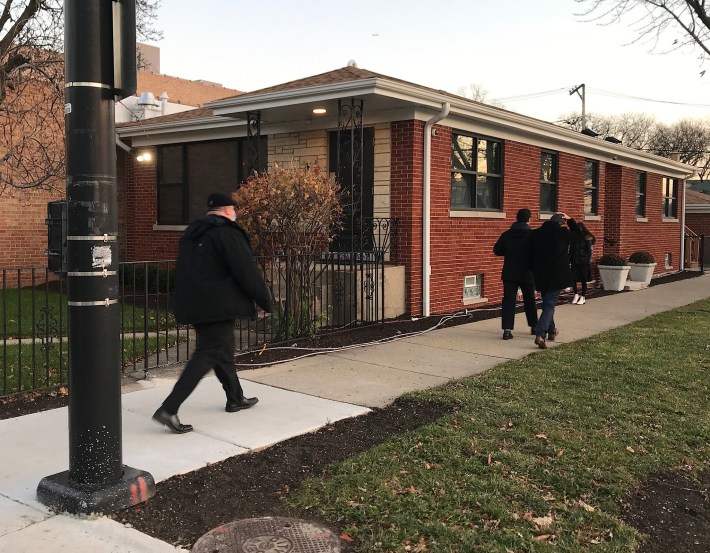
When I stopped by the neighborhood on a recent Friday as the sun descended, the sidewalks were fairly bustling with black-clad men, women, and children hurrying to Shabbat services, and the streets were relatively tranquil since their cars were parked.
The ritual perimeter makes it practical to observe Talmudic law, which forbids carrying objects outside of one's home on the Sabbath, save for the clothes you're wearing, Reiss explained. The eruv, Hebrew for "mixing," addresses this rule by symbolically combining all households within the boundaries into one symbolic domestic space. Therefore, within the district it's acceptable to carry your house key, a prayer book, eyeglasses, or medicine, and push a baby stroller or use a cane, crutches, or a wheelchair.

On the other hand, muktzeh, items that can't be carried on Shabbos, even within one’s home, include money, wallets, purses, phones, writing implements, office keys, and other objects associated with commerce or labor. Even umbrellas are forbidden, which must make walking to synagogue a challenge when there’s a downpour.
Others commonplace actions that are forbidden on the Sabbath include turning on lights and stoves, so advanced planning is required. It used to be fairly common for Jews to ask or hire gentiles to take care of such tasks, although Reiss said that's not really a thing in contemporary West Rogers Park. Famous Shabbos goyim (non-Jewish Sabbath helpers) included Elvis Presley, who assisted a rabbi's family who lived upstairs from him in a Memphis two-flat during the early 1950s, and Barack Obama, who used to help Alderman Silverstein's husband Ira with electric doors when the two of them shared an office suite as Illinois state senators in 1999.
The website for the West Rogers Park Eruv includes a hotline residents can call after 2 PM on Fridays to double-check that the wall, wire, and post perimeter, which is inspected regularly, is still intact. "Please remember that if the eruv is not operational, carrying in the public domain may be a serious transgression," the site warns.
Here are the general boundaries of the zone:
- To the west: the Kedzie Avenue side of the North Shore Channel fence
- To the north: the CTA Yellow Line 'L' racks
- To the east: The Chicago Northwestern Railroad Tracks
- To the south: The Rosehill Cemetery wall, and wires that run on the south Side of Peterson until Lincoln Avenue, and continue northwest along Lincoln to Kedzie
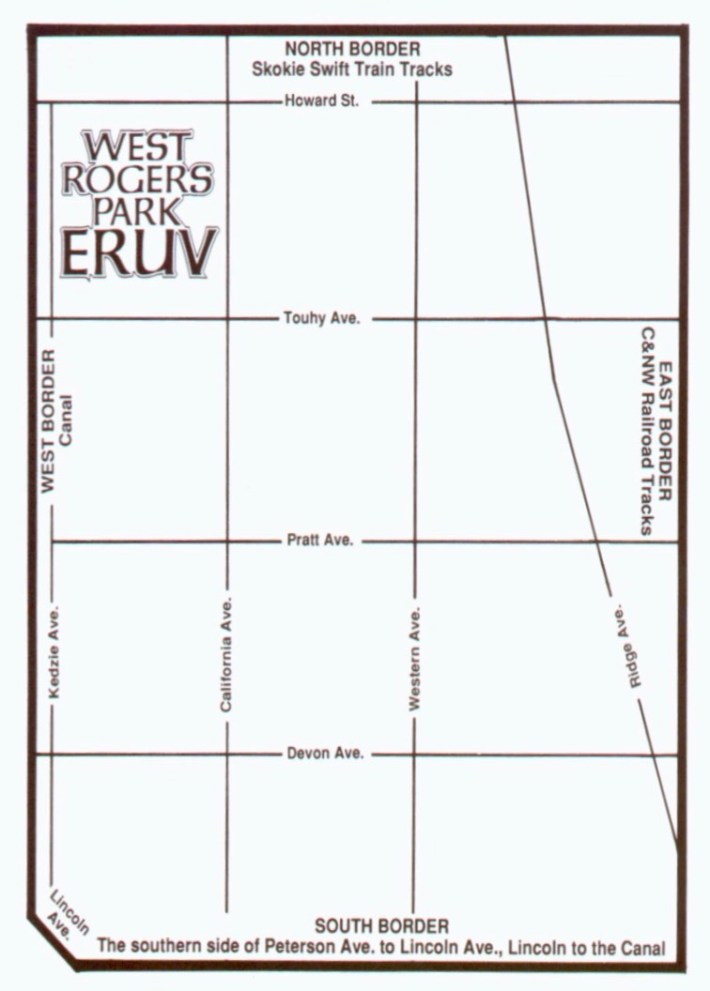
The website provides more details on what is and what isn't permitted within the eruv. Interestingly, there's a whole section noting that while young children are allowed to keep themselves occupied with ball-playing in the backyard, that guideline has sometimes been "misconstrued [as] allowing everything shy of a Little League team," sternly warning, "The Talmud Yerushalmi (Taanis 4:5) records that the city of Tur Shimon [near Jerusalem] was destroyed exclusively because of ball playing on Shabbos."
After calling a few more rabbis listed on the website, I learned the identity of the person who met with CDOT about installing the arch, a real estate lawyer and eruv committee founder named Robert W. Matanky. He told me he identifies as "a centrist Orthodox Jew—I'm engaged with the world; I'm not insular."
Matanky said he was involved in the early discussions about the bike bridge back in the mid-2000s, "because it was going to disturb the eruv boundary." The halakhic guidelines require that if there is an opening in the ritual enclosure, there must be two objects signifying doorposts, plus a header. "The design was missing the door."
When Alderman Stone vetoed the span in 2005, he publicly stated a few different reasons for his opposition, none of which made much sense. But Matanky said Stone was actually hoping to use the project funding to build a pedestrian bridge over the channel a half mile north of Lincoln near Albion Avenue, to provide a shortcut over the waterway for people walking between two residential areas. One likely reason that didn't happen is because the bike path doesn't exist that far north on the east bank, so the structure would have been useless for making the needed trail connection.
When Debra Silverstein rebooted the project years later, Matanky met with the CDOT designers and engineers to propose an eruv-friendly solution. "I think we came up with something aesthetically very nice, so everybody came out a winner."
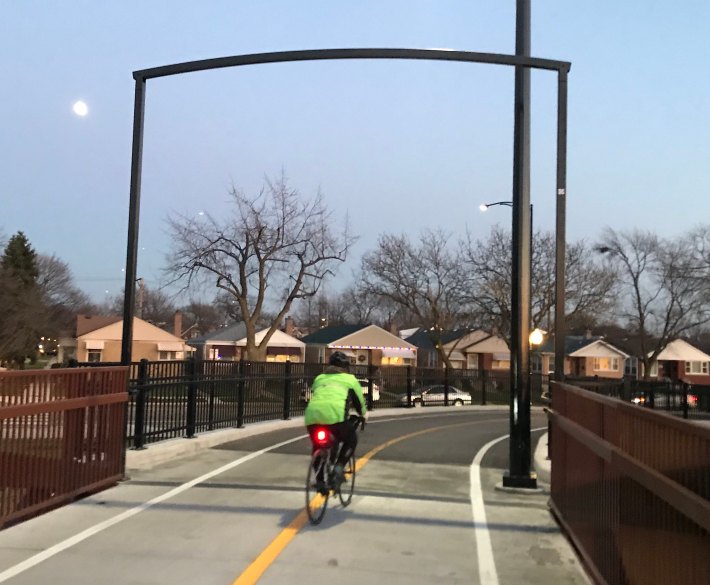
Establishing, inspecting, and maintaining an eruv is a surprisingly complex endeavor. For example, Matanky said that to establish the southern boundary of the West Rogers Park District years ago, the committee had to get permission from CDOT to attach brackets to existing light poles to string the cable on the south side of Peterson from Western to Lincoln, and then on to Kedzie. "That was done without tax money, using contributions from community members."
But Rabbi Reiss said all that effort is worth it. "Shabbos is a beautiful day, and the eruv enables people to enjoy the day to the fullest, in the proper sanctity of the Sabbath."
